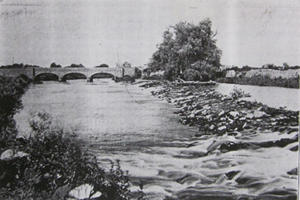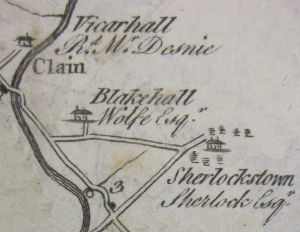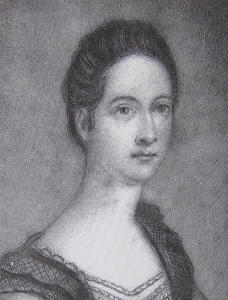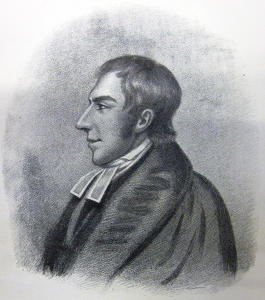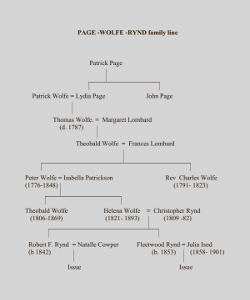Know your Townland – Blackhall
Published in Le Chéile, June 2014
Ancient Road
Blackhall is a townland adjoining Clane on the south side of the River Liffey. It has an eventful past with connections to almost every period in history. In the pre-historic times it was on the path of the ancient provincial road that linked Nás na Riogh the capital of Leinster with Tara. This road extended on an Esker for much of its course to the Liffey at Clane. A feature of Blackhall today is the elevated ridge that extends through the townland which marked the site of the pre-historic road. The road crossed the Liffey at the ancient ford between Clane and Blackhall.1
Placename
The place name Blackhall dates from the Norman period and comes from a ‘Hall House’ which was a category of a castle or stone house from that period. It is likely that the dark coloured stone that was used in the construction of this building gave its name to the townland. Records also indicate that another medieval fortification referred to as ‘Black Castle’ existed in Clane at this period.2 It is likely the stone used in the construction of both castles came from the same quarry.
Maurice FitzGerald
The FitzGerald family are the earliest known landowners of Blackhall and they can link their ownership back to Maurice FitzGerald one of the original Norman adventurers. He obtained a grant of an area encompassing the Barony of Naas which included Blackhall in 1172. His descendents continued to hold the townland throughout the medieval period until the mid 17th century.
Wars of the 1640s
Following the rebellion of 1641 many local landowners sided with the Confederate rebels including the FitzGeralds of Blackhall. In 1642 the Earl of Ormond who was the Kings representative in the country sent army into county Kildare and they captured and destroyed numerous Confederate castles including Blackhall. It is known that the castle was rebuilt in 1654 as this was recorded in the civil survey which indicated that a ‘castle in Blackhall was under reconstruction’. The survey also mentioned a corn mill that was also in the process of been rebuilt.3 It was sited on the Blackhall side of the River Liffey close to Clane bridge and was powered by the flow of water from a weir. Its location is shown on various 18th and 19th century maps and in recent times was known as Slevins Mill.4
In the survey of 1654 the estimated area of Blackhall was 200 acres with the land described as arable. The measure, however, used to determine an acre, was not the statute measurement used today. The value of the lands as they were let or worth to be let in 1640 was given as £50. The owner of the townland at the time was William FitzGerald of Blackhall. Mention was also made of a large area of common land that belonged to the lands of Blackhall.5 A census from 1659, indicated that Blackhall had a population of 35, in which all the residents were described as Irish. The only individual named in the census was Anthony Sherlock who more than likely lived in Blackhall Castle.6 Despite the devastation of the Confederate Wars the townland was far from depopulated and had a moderately higher population than the 29 individuals recorded in the 1901 census.
Wogan’s of Blackhall
A branch of the Wogan family also had connections with Blackhall in the 17th century. Nicholas Wogan a member of the Wogans of Newhall lived in Blackhall for a short time prior to his death in 1636. One of his sons Edward had an outstanding military career during the English Civil War in the 1640s. He was born in Blackhall in 1626 and moved to live with relatives in England. He initially served under Cromwell but defected to the side of King Charles. At the battle of Nasby in 1645 he is accredited with saving the Kings life. When the war ended in England, Wogan returned to Ireland to continue his fight against Cromwell and successfully defended the fort of Duncannon in 1649. He subsequently took part in Royalist uprisings of 1651 to 1654 in Scotland. He died following an encounter with Cromwellian supporters in Scotland in 1654, aged 28.7
Page and Wolfe Family
In the late 17th century Blackhall came into the possession of Patrick Page. Following his death the townland passed to his son John whose sister Lydia married Richard Wolfe of Fornaughts. Their son Thomas Wolfe shortly before 1732 obtained the lease of Blackhall from his uncle John Page. This family link with Blackhall was to continue until the 20th century.
Blackhall House
A substantial two story over basement house replaced the Castle at Blackhall as the principal dwelling in the townland in the early 18th century. It is not known for definite when the house was built but most historians point to its construction during the lifetime of Thomas Wolfe who had acquired the estate in the 1730s. The house consisted of a seven bay front, with the three centre bays been recesses. It had a flat roof with what was referred to as ‘a fantastic cupola sprouting from it’.8 Thomas Wolfe died in 1787 and his son Theobald succeeded to the lands.9
Margaret Lamport
One of the more famous although largely forgotten individuals connected with Blackhall House was Margaret Lamport who was a leading member of the Wolfe household staff in the early 1760’s. Margaret belonged to a shipping family from Drogheda where her father Captain Lamport was skipper of a ship that traded from the port. Margaret held an important position as a leading assistant and companion to the wife of Thomas Wolfe. Due to her religious affiliation, her prominent position in the household staff was unusual at the time. The Wolfe family were members of the Established Church and Margaret was a Catholic. In 1762, Margaret married Peter Tone the son and heir of a local farmer from nearby Bodenstown. They relocated to Dublin where their eldest son Theobald Wolfe Tone was born. Theobald Wolfe son and heir of the owner of Blackhall Estate was godfather to the child who was given his godfathers name. This was not unusual at the time as Wolfe Tone himself in later years named two of his sons after their godfather. Margaret Lamport Tone died almost forgotten in Phibsborough in 1818 and was buried in the family plot in Bodenstown Churchyard.10
Wolfe Family and 1798
In the turbulent period of the 1790s the Wolfe family were opponents of the United Irishmen. On the night of the outbreak of the Rising in 1798, Theobald Wolfe was tipped off by sympatric rebels of the danger and together with his family managed to escape from the house. They made their way to Dublin before moving for a short time to Cheltenham, England. According to the family, an interesting incident occurred relating to the family pet a dog named ‘Tip’. The dog was left behind in the house when they fled in 1798 but mysteriously turned up at their English residence some weeks later. The story survived for many generations mainly due to the fact that there was an engraving of the dog in Blackhall House.11
Rev Charles Wolfe (1791–1831)
Theobald Wolfe had eleven children and the youngest Charles was to become the most famous member of the family. He was born at Blackhall in 1791 and chose a career as a clergymen but his main call to fame was as a poet. In 1825 he published his only volume of verse, ‘Poetical Remains’ and it included ‘The Burial of Sir John Moore after Cronna’. This verse became one of the most famous poems from the period and was on the primary school curriculum in Great Britain throughout the 19th and 20th centuries and also in Ireland until Independence. Charles died of consumption in Cobh in 1823 at a relatively young age of 31.12
Wolfe Family in the 19th Century
Following the death of Theobald Wolfe in 1799 the ownership of Blackhall passed to his senior surviving son Peter. Both Peter and his younger brother James assisted in local security affairs in the decade after 1798. Peter served as High Sheriff of the county in 1805 and James served as a Major in the Kildare Militia. Peter’s second son William chose an army career and obtained the rank of Colonel. During the 1850s, he took part in the Crimea War. Peter Wolfe had eight children five boys and three girls. However, his daughter Helena was the only one of his offspring that ever married. John Wolfe was the last member of the family to reside in Blackhall and following his death in 1870 the estate passed to his nephew Robert Rynd the eldest son of his sister Helena Wolfe who had married Christopher Rynd of Mountarmstrong.13 The Rynd family were prominent in the area and Christopher was brother to Dr. Francis Rynd who obtained fame as a Physician who is accreted with inventing the hollow needle used in hypodermic syringes. The family link to Blackhall extending back seven generations came to an end in the first decade of the 20th century when Robert Rynd sold the townland in 1907.14
Footnotes
- Hermann Geissel, Shady Road to Clane, p. 96.
- This castle was held by the Sarsfield family in Clane and may not have been Blackhall.
- Robert Simmington, The Civil Survey AD 1654–56, Vol. VIII, County Kildare (Dublin, 1952), p. 62.
- See OS Map 1837.
- Simmington, Civil Survey, p. 62.
- Seamus Pender, Census of Ireland, 1659 (Dublin, 1939), p. 397.
- Matthew Devitt, Rathcoffey, in JKAS, Vol. III, pp 83, 87.
- Mark Bence-Jones, A guide to Irish Country Houses, (London, 1988), p. 42.
- George Wolfe, The Wolfe family of County Kildare, in JKAS, Vol. III, pp 361–367.
- Seamus Cullen, Wolfe Tone and his Family Connections with Co Kildare, in The Kildare Nationalist, September 2009.
- Wolfe, The Wolfe family of County Kildare.
- Wolfe, The Wolfe family of County Kildare.
- Sir Bernard Burke, Landed Gentry of Ireland (London, 1912), pp 614–15.
- Kildare Observer, July 1907, for details of the sale of Blackhall.

